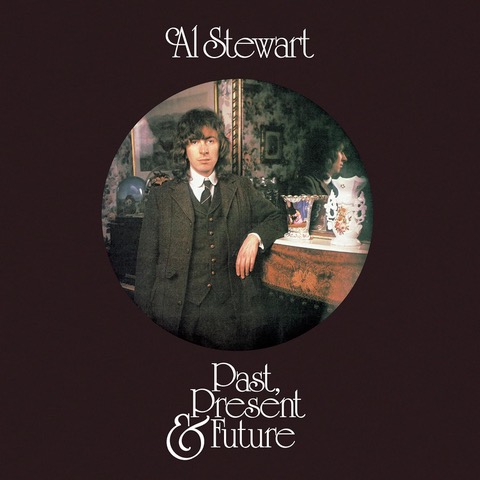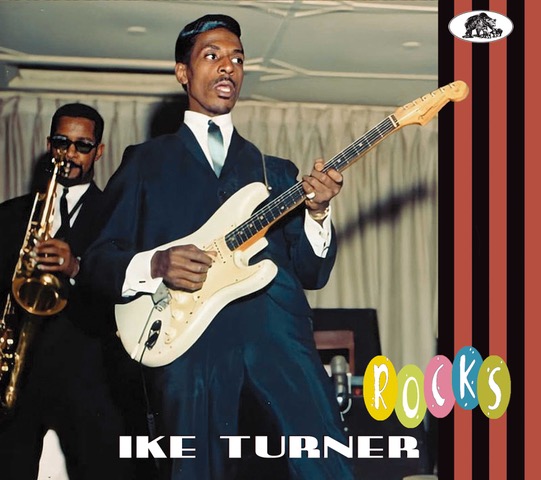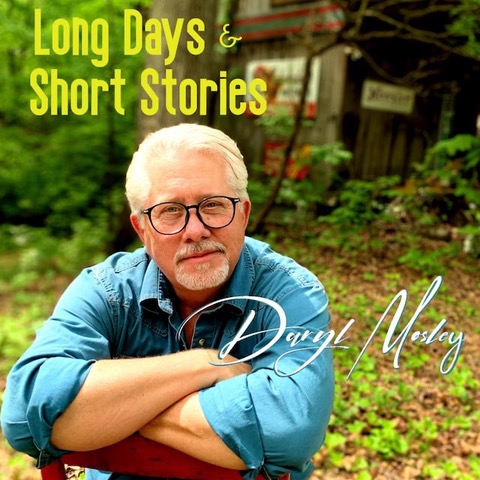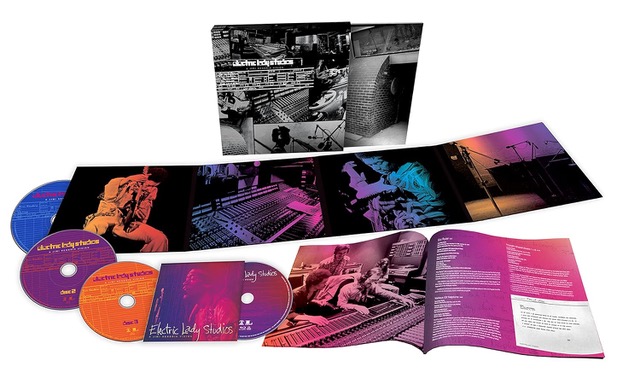A Celebration of Jimi Hendrix and His Electric Lady Studios
Way back in 1982, in a review of an album of previously unavailable material called The Jimi Hendrix Concerts, this writer expressed surprise that a dozen years after the guitarist’s death, “anything at all remains left to release.” In fact, that 1982 double-LP turned out to offer a mere tiny taste of what would follow. It has now been more than half a century since Hendrix’s passing and heretofore unheard music keeps on coming.
The latest offering is a box set called Electric Lady Studios: A Jimi Hendrix Vision. On three CDs (or five LPs), it delivers 39 tracks, only one of which has previously been released. All of it was recorded between November 1969 and August 1970. On most of the numbers, Hendrix is backed by Billy Cox on bass and Mitch Mitchell on drums, though Buddy Miles mans the drum kit on a few tracks and a few other players, including Stevie Winwood, make occasional contributions.

Much of the program consists of alternate versions of songs that wound up on the posthumously released First Rays of the New Rising Sun. The package also includes covers of Bob Dylan’s “Drifter’s Escape” and the blues standard “Farther Up the Road,” and there are several extended jams, among them one that incorporates elements of five songs and clocks in at more than 26 minutes.
The box supplements the CDs with a Blu-ray that offers an engrossing hour-and-a-half-long documentary about the creation of Hendrix’s Electric Lady Studios, where he recorded all this material. Also on the Blu-ray are surround-sound versions of all 17 songs from First Rays of the New Rising Sun and three bonus tracks. A 48-page booklet includes photos, handwritten song drafts, and liner notes.
Throughout, the sound quality is excellent, and Hendrix’s guitar work is rarely less than astonishing.
A Box Set Marks the 50th Anniversary of an Al Stewart Classic

Al Stewart was a relatively little-known Scottish singer/songwriter when he started working on the album that would become Past, Present & Future. A history buff, he initially planned to include one song for each decade of the 20th century. The concept evolved a bit over the five years he worked on the LP, but the historical focus remained. Most of the songs tell tales set in the first half of the 1900s while a nearly 10-minute album-closing number focuses on the predictions of Nostradamus, the 16th-century seer.
The October 1973 album, Stewart’s fifth LP and first U.S. release, didn’t sell nearly as well as such later offerings as Year of the Cat and Time Passages; it stalled at No. 133 on the Billboard charts while those subsequent albums both made the Top 10 as did their title-cut singles. Arguably, though, Past, Present & Future remains Stewart’s best work.
The music is consistently engaging and impressively varied—everything from the 1950s-rock-influenced “Post World War II Blues” to “Terminal Eyes,” an apparent nod to the Beatles’ “I Am the Walrus.” Stewart reportedly read 40 history books to get the facts right in the lyrics for tracks such as “Old Admirals,” “Warren Harding,” “Soho (Needless to Say),” “The Last Day of June 1934,” and “Roads to Moscow.” The results are colorful, evocative, and richly detailed.
Consider, for example, the seemingly autobiographical “Post World War Two Blues,” which begins:
I was a post-war baby in a small Scots town
I was three years old when we moved down south
Hard times written in my mother’s looks
With her widow’s pension and her ration book
Aneurin Bevan took the miners’ cause
To the House of Commons, in his coal-dust voice
We were locked up safe and warm from the snow
With Life with the Lyons on the radio
And Churchill said to Louis Mountbatten
‘I just can’t stand to see you today
How could you have gone and given India away?’
The song goes on to namecheck Buddy Holly, TV’s That Was the Week That Was, English model Christine Keeler, Allen Ginsberg, Robert Kennedy, Jimi Hendrix, the Beatles’ Sergeant Pepper, and Bob Dylan’s “Desolation Row.”
England’s Esoteric label recently marked the 50th anniversary of this great album’s release by issuing a four-disc box set that adds immeasurably to the original recording. It comes with a poster, art postcards, and a 64-page illustrated booklet that contains all the lyrics, reminiscences by Stewart and others, and copies of newspaper reviews and interviews.
The set’s first disc offers a remaster of the original album plus single versions of “Nostradamus” and “Terminal Eyes” and a song called “Swallow Wind” that previously showed up as a bonus track on a reissue of 1975’s Modern Times. Disc Two adds a previously unreleased 1974 concert with guest Andy Powell of Wishbone Ash. It features most of the numbers from Past, Present & Future plus an 11-minute cover of Bob Dylan’s “All Along the Watchtower” and two other tracks. The third CD delivers excellent new stereo mixes of the original album and “Swallow Wind.” But the cream of the crop is on the box’s Blu-ray disc, where you’ll find several hi-res mixes of the original album, most notably a stunning 5.1 surround-sound version.
If you’re a fan of Past, Present & Future, you need this box. And if you’re not familiar with it, there’s no better way to get acquainted.
Also Noteworthy

Ike Turner, Rocks. Ike Turner is known today mostly for his 1960s work with Tina Turner (and for being her abusive husband). Earlier, however, he delivered a truckload of groundbreaking R&B and rock. You’ll find some of the best of it in this anthology, which comes with a 40-page booklet that includes detailed liner notes and discographic information. The 33-track, 79-minute set embraces many numbers released under Turner’s name as well as his work, mostly on guitar, with other artists from 1951 to 1961.
The oldest selection on the CD is “Rocket 88,” an R&B chart-topper that is often cited as the first rock and roll recording. The song is credited to Jackie Brenston, who delivers the high-energy vocals, but the hard-rocking band behind him is Ike Turner and his Kings of Rhythm. Among the anthology’s many other highlights are “(I Know) You Don’t Love Me,” which incorporates a rollicking horn section, “Ho-Ho,” which is loaded with examples of Turner’s guitar pyrotechnics, and “Looking for My Baby,” which features a vocal by Bonnie Turner, one of Ike’s 14 wives. (And no, 14 is not a typo.)

Michelle Malone, Southern Comfort. Michelle Malone sings passionately throughout Southern Comfort, the latest offering from an artist who has been making music for more than three decades. The 11-track program consists solely of songs that she wrote or co-wrote, including five collaborations with veteran singer/songwriter Dean Dillon, who has penned hits for George Strait and others.
On the title cut, Georgia native Malone sings about being stuck in a hotel room in New York City and wishing she was “home to see the dogwood bloom.” Other standouts include “I Choke on My Words,” where she looks back with regret on mistakes she has made over the years; the emotive “Easter Sunday,” about the day a love began; and the anthemic “Believe,” about a lost love.
The album, which balances up-tempo material and ballads, is rock-based but draws on country and folk. Malone, who plays guitars and harmonica, is backed by a septet that adds such instruments as mandolin, lap steel, piano, and cello. Guests on various tracks include Randall Bramblett, Buddy Miller, Will Kimbrough, the Georgia Satellites’ Rick Richards, and Charlie Parr.

Daryl Mosley, Long Days & Short Stories. Longtime bluegrass musician Daryl Mosley – whose resume lists stints with New Tradition and the Osborne Brothers – is at the top of his game on this fourth solo album. Mosley, whose rich vocals sound redolent of Ricky Skaggs’s, plays bass on the set, which employs a crack ensemble that incorporates mandolin, guitar, banjo, fiddle, and piano.
Mosley’s self-penned material, which draws on gospel, country, and Americana, addresses friendship, faith, aging, romantic love, and other universal topics. The best songs include “Forever After All,” about a long and satisfying marriage; “Still the Solid Rock,” which features New Tradition; and “When the Good Old Days Were New,” which exemplifies Mosley’s ability to cogently and deftly tell a tale. Sample couplet: “Dad went to the Navy until Truman dropped the bomb / And what was left of him came home to Mom.”
Jeff Burger’s website, byjeffburger.com, contains five decades’ worth of music reviews, interviews, and commentary. His books include Dylan on Dylan: Interviews and Encounters, Lennon on Lennon: Conversations with John Lennon, Leonard Cohen on Leonard Cohen: Interviews and Encounters, and Springsteen on Springsteen: Interviews, Speeches, and Encounters.



